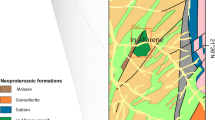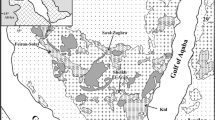Abstract
The Khopoli intrusion, exposed at the base of the Thakurvadi Formation of the Deccan Traps in the Western Ghats, India, is composed of olivine gabbro with 50–55 % modal olivine, 20–25 % plagioclase, 10–15 % clinopyroxene, 5–10 % low-Ca pyroxene, and <5 % Fe-Ti oxides. It represents a cumulate rock from which trapped interstitial liquid was almost completely expelled. The Khopoli olivine gabbros have high MgO (23.5–26.9 wt.%), Ni (733–883 ppm) and Cr (1,432–1,048 ppm), and low concentrations of incompatible elements including the rare earth elements (REE). The compositions of the most primitive cumulus olivine and clinopyroxene indicate that the parental magma of the Khopoli intrusion was an evolved basaltic melt (Mg# 49–58). Calculated parental melt compositions in equilibrium with clinopyroxene are moderately enriched in the light REE and show many similarities with Deccan tholeiitic basalts of the Bushe, Khandala and Thakurvadi Formations. Nd-Sr isotopic compositions of Khopoli olivine gabbros (εNdt = −9.0 to −12.7; 87Sr/86Sr = 0.7088–0.7285) indicate crustal contamination. AFC modelling suggests that the Khopoli olivine gabbros were derived from a Thakurvadi or Khandala-like basaltic melt with variable degrees of crustal contamination. Unlike the commonly alkalic, pre- and post-volcanic intrusions known in the Deccan Traps, the Khopoli intrusion provides a window to the shallow subvolcanic architecture and magmatic processes associated with the main tholeiitic flood basalt sequence. Measured true density values of the Khopoli olivine gabbros are as high as 3.06 g/cm3, and such high-level olivine-rich intrusions in flood basalt provinces can also explain geophysical observations such as high gravity anomalies and high seismic velocity crustal horizons.












Similar content being viewed by others
References
Anders E, Grevesse N (1989) Abundances of the elements: meteoritic and solar. Geochim Cosmochim Acta 53:197–214
Beane JE (1988) Flow stratigraphy, chemical variation and petrogenesis of Deccan flood basalts from the Western Ghats, India. PhD Dissertation, Washington State University, USA
Beane JE, Hooper PR (1988) A note on the picrite basalts of the Western Ghats, Deccan Traps, India. In: Subbarao KV (ed) Deccan flood basalts. Geol Soc Ind Mem 10:117–133
Beane JE, Turner CA, Hooper PR, Subbarao KV, Walsh JN (1986) Stratigraphy, composition and form of the Deccan basalts, Western Ghats, India. Bull Volcanol 48:61–83
Best MG (2003) Igneous and Metamorphic Petrology, 2nd ed. Blackwell Science Ltd
Bhattacharji S, Sharma R, Chatterjee N (2004) Two- and three-dimensional gravity modelling along western continental margin and intraplate Narmada-Tapti rifts: its relevance to Deccan flood basalt volcanism. In: Sheth HC, Pande K (eds) Magmatism in India through time. Proc Ind Acad Sci (Earth Planet Sci) 113:771–784
Bhattacharya S, Choudhary AK, Basei M (2012) Original nature and source of khondalites in the Eastern Ghats province, India. In: Mazumder R, Saha D (eds) Palaeoproterozoic of India. Geol Soc Lond Spec Publ 365:145–158
Bondre NR, Hart WK, Sheth HC (2006) Geology and geochemistry of the Sangamner mafic dyke swarm, western Deccan volcanic province, India: implications for regional stratigraphy. J Geol 114:155–170
Bose MK (1973) Petrology and geochemistry of the igneous complex of Mount Girnar, Gujarat, India. Contrib Mineral Petrol 39:247–266
Chandrasekharam D, Mahoney JJ, Sheth HC, Duncan RA (1999) Elemental and Nd-Sr-Pb isotope geochemistry of flows and dykes from the Tapi rift, Deccan flood basalt province, India. J Volcanol Geotherm Res 93:111–123
Cox KG (1980) A model for flood basalt vulcanism. J Petrol 21:629–650
Cox KG (1988) The Karoo province. In: Macdougall JD (ed) Continental Flood Basalts. Kluwer Academic Publishers, Dordrecht, pp 239–272
DePaolo DJ (1981) Trace element and isotopic effects of combined wallrock assimilation and fractional crystallization. Earth Planet Sci Lett 53:189–202
Duraiswami RA, Shaikh TN (2013) Geology of the saucer-shaped sill near Mahad, western Deccan Traps, India, and its significance to the flood basalt model. Bull Volcanol 75:731. doi:10.1007/s00445-013-0731-4
Glennie EA (1951) Density or geological corrections to gravity anomalies for the Deccan Trap areas in India. Roy Astron Soc Geophys Suppl 6:179–193
Godbole SM, Ray B (1996) Intrusive rocks of coastal Maharashtra. In: Deshmukh SS, Nair KKK, Yedekar DB, Mohabey DM, Chatterjee AK (eds) Deccan basalts. Gondwana Geol Mag Sp Vol 2:233–250
Green TH, Blundy JD, Adam J, Yaxley GM (2000) SIMS determination of trace element partition coefficients between garnet, clinopyroxene and hydrous basaltic liquids at 2–7.5 GPa and 1080–1200°C. Lithos 53:165–187
Grove TL, Juster TC (1989) Experimental investigations of low-Ca pyroxene stability and olivine-pyroxene-liquid equilibria at 1-atm in natural basaltic and andesitic liquids. Contrib Mineral Petrol 103:287–305
Herzberg C, O'Hara MJ (2002) Plume-associated ultramafic magmas of Phanerozoic age. J Petrol 43:1857–1883
Ionov DA, Bodinier JL, Mukasa SB, Zanetti A (2002) Mechanisms and sources of mantle metasomatism: major and trace element conditions of peridotite xenoliths from Spitzbergen in the context of numerical modelling. J Petrol 43:2219–2259
Ishii T (1975) The relations between temperature and composition of pigeonite in some lavas and their application to geothermometry. Miner J 8:48–57
Khadri SFR, Subbarao KV, Hooper PR, Walsh JN (1988) Stratigraphy of Thakurvadi Formation, western Deccan basalt province, India. In: Subbarao KV (ed) Deccan flood basalts. Geol Soc Ind Mem 10:281–304
Krishnamurthy P, Cox KG (1977) Picrite basalts and related lavas from the Deccan Traps of western India. Contrib Mineral Petrol 62:53–75
Krishnamurthy P, Gopalan K, Macdougall JD (2000) Olivine compositions in picrite basalts and the Deccan volcanic cycle. J Petrol 41:1057–1069
Loucks RR (1996) A precise olivine-augite Mg-Fe-exchange geothermometer. Contrib Mineral Petrol 125:140–150
Lyubetskaya T, Korenaga J (2007) Chemical composition of Earth’s primitive mantle and its variance: 1. Method and results. J Geophys Res 112, B03211. doi:10.1029/2005JB004223
Melluso L, Sethna SF (2011) Mineral compositions in the Deccan igneous rocks of India: an overview. In: Ray J, Sen G, Ghosh B (eds) Topics in Igneous Petrology, 135–160. Springer
Melluso L, Barbieri M, Beccaluva L (2004) Chemical evolution, petrogenesis, and regional chemical correlations of the flood basalt sequence in the central Deccan Traps, India. In: Sheth HC, Pande K (eds) Magmatism in India through time. Proc Ind Acad Sci 113:587–603
Melluso L, Mahoney JJ, Dallai L (2006) Mantle sources and crustal input as recorded in High-Mg Deccan Trap basalts of Gujarat (India). Lithos 89:259–274
Melluso L, de’Gennaro R, Rocco I (2010) Compositional variations of chromiferous spinel in Mg-rich rocks of the Deccan Traps, India. J Earth Syst Sci 119:343–363
Miller C, Zanetti A, Thöni M, Konzett J, Klötzli U (2012) Mafic and silica-rich glasses in mantle xenoliths from Wau-en-Namus, Libya: textural and geochemical evidence for peridotite—melt reactions. Lithos 128–131:11–26
Mulay JG, Peshwa VV (1980) The occurrence of gabbroic intrusion in Deccan Trap basalts near Khopoli in the Konkan area (Maharashtra). Curr Sci 49:356–357
Negi JG, Agrawal PK, Singh AP, Pandey OP (1992) Bombay gravity high and eruption of Deccan flood basalts (India) from a shallow secondary plume. Tectonophysics 206:341–350
Pandey OP (2008) Deccan Trap volcanic eruption affected the Archaean Dharwar craton of southern India: seismic evidences. J Geol Soc India 72:510–514
Peng ZX, Mahoney JJ, Hooper P, Harris C, Beane J (1994) A role for lower continental crust in flood basalt genesis? Isotopic and incompatible element study of the lower six formations of the western Deccan Traps. Geochim Cosmochim Acta 58:267–288
Putirka K (2008) Thermometers and barometers for volcanic systems. In: Putirka K, Tepley F (eds) Minerals, inclusions and volcanic processes. Rev Mineral Geochem 69:61–120. Amer Min Soc, Washington, DC
Ray R, Sheth HC, Mallik J (2007) Structure and emplacement of the Nandurbar-Dhule mafic dyke swarm, Deccan Traps, and the tectonomagmatic evolution of flood basalts. Bull Volcanol 69:531–537
Ray R, Shukla AD, Sheth HC, Ray JS, Duraiswami RA, Vanderkluysen L, Rautela CS, Mallik J (2008) Highly heterogeneous Precambrian basement under the central Deccan Traps, India: direct evidence from xenoliths in dykes. Gondwana Res 13:375–385
Roeder PL, Emslie RF (1970) Olivine-liquid equilibrium. Contrib Mineral Petrol 29:275–289
Sheth HC, Ray JS, Ray R, Vanderkluysen L, Mahoney JJ, Kumar A, Shukla AD, Das P, Adhikhari S, Jana B (2009) Geology and geochemistry of Pachmarhi dykes and sills, Satpura Gondwana Basin, central India: problems of dyke-sill-flow correlations in the Deccan Traps. Contrib Mineral Petrol 158:357–380
Sheth HC, Choudhary AK, Bhattacharyya S, Cucciniello C, Laishram R, Gurav T (2011) The Chogat-Chamardi subvolcanic complex, Saurashtra, northwestern Deccan Traps: geology, petrochemistry, and petrogenetic evolution. J Asian Earth Sci 41:307–324
Subbarao KV, Hooper PR (1988) Reconnaissance map of the Deccan Basalt Group in the Western Ghats, India. In: Subbarao KV (ed) Deccan flood basalts. Geol Soc Ind Mem 10:enclosure
Sukheswala RN, Sethna SF (1973) Oversaturated and undersaturated differentiates in the tholeiitic igneous complex of Phenai Mata, Baroda district, Gujarat state, India. N Jb Miner Abh 118:159–176
Takin M (1966) An interpretation of the positive gravity anomaly over Bombay on the west coast of India. J Astron Soc Geophys Suppl 11:527–537
van Achterbergh E, Ryan CG, Jackson SE, Griffin W (2001) Data reduction software for LA-ICP-MS. In: Sylvester P (ed) Laser Ablation-ICPMS in the earth science. Short course series 29. Mineralogical Association of Canada, 239–243
Van Keulen J (1973) Density of porous solids. Mater Struct 6:181–183
Vanderkluysen L, Mahoney JJ, Hooper PR, Sheth HC, Ray R (2011) The feeder system of the Deccan Traps (India): insights from dyke geochemistry. J Petrol 52:315–343
Villiger S, Ulmer P, Muentener O (2007) Equilibrium and fractional crystallisation experiments at 0.7 GPa; the effect of pressure on phase relations and liquid compositions of tholeiitic magmas. J Petrol 48:159–184
Wilson SA (1997) Data compilation for USGS reference material BCR-2, Columbia River basalt. US Geol Surv Open File Rep
Wilson SA (2000) Data compilation for USGS reference material BHVO-2, Hawaiian basalt. US Geol Surv Open File Rep
Zellmer GF, Sheth HC, Iizuka Y, Lai Y-J (2012) Remobilization of granitoid rocks through mafic recharge: evidence from basalt-trachyte mingling and hybridization in the Manori-Gorai area, Mumbai, Deccan Traps. Bull Volcanol 74:47–66
Acknowledgements
Funds for EPMA and LA-ICPMS analyses by Cucciniello were provided by Italian MIUR (PRIN Grants 2008 to Leone Melluso). We thank Ron Fodor, Nilanjan Chatterjee and Leone Melluso for helpful critical reviews of an earlier version of the manuscript. The present version greatly benefited from the constructive, critical reviews of Loÿc Vanderkluysen and an anonymous reviewer, and comments and suggestions by the Editor Johann G. Raith. Their contributions are much appreciated. Leone Melluso and Sam Sethna are thanked for providing the sample BU6 as well as many unpublished mineral analyses from the Deccan Traps. We will always gratefully remember the late John Mahoney for his enthusiasm, encouragement, and friendship.
Author information
Authors and Affiliations
Corresponding author
Additional information
Editorial handling: L. G. Gwalani
Electronic supplementary material
Below is the link to the electronic supplementary material.
ESM 1
(XLS 150 kb)
Supplementary Figure 1
Photomicrographs of the Khopoli olivine gabbro samples investigated with laser ablation inductively coupled plasma mass spectrometry (LA-ICPMS). The locations of laser pits are also shown. (JPEG 297 kb)
Rights and permissions
About this article
Cite this article
Cucciniello, C., Choudhary, A.K., Zanetti, A. et al. Mineralogy, geochemistry and petrogenesis of the Khopoli mafic intrusion, Deccan Traps, India. Miner Petrol 108, 333–351 (2014). https://doi.org/10.1007/s00710-013-0309-z
Received:
Accepted:
Published:
Issue Date:
DOI: https://doi.org/10.1007/s00710-013-0309-z




